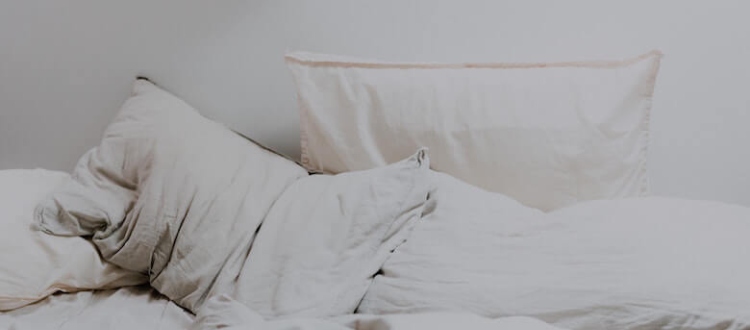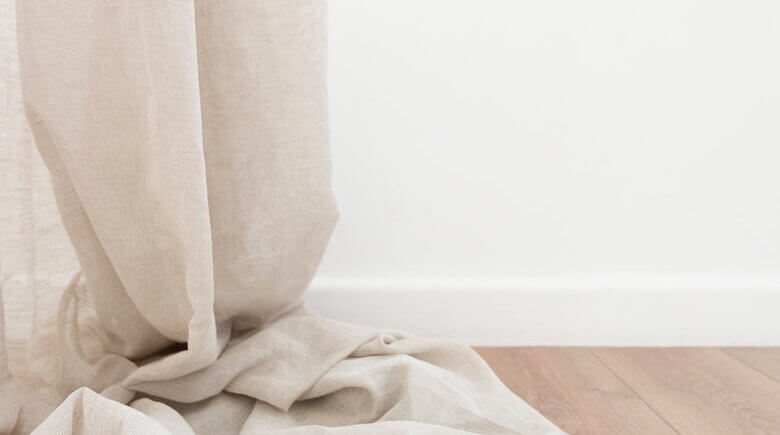
Is Linen a Natural Fabric?
Is linen a natural fabric?
As many of us are trying to live and shop more sustainably, we're looking for home textiles and clothing made from natural fabrics. It's easier than ever to find out what different businesses and brands are doing to reduce their carbon footprint. But how do we know whether the fabrics we're buying are purely sourced and carefully produced?
In this post we're going to highlight the benefits of natural fabrics (for you and for the planet) and show you why linen makes the ideal choice if sustainability and eco-friendliness are a priority. And linen doesn't not only score top marks in environmental terms – it's timelessly beautiful, always on-trend, comes in a huge range of colors and patterns, and will add a simple, effortless charm to your interior or wardrobe. Read on to find out more about this amazing material.
What is a natural fabric?

Generally, a natural fabric is one that is grown and produced from a plant. This could be wild or a commercially cultivated crop, but most of the fabrics we use today come from substantial farms and producers. The flax plant grows in temperate regions like North Western Europe and has been used around the world for thousands of years to produce linen textiles like bedding, clothing, woven rope and many other items from wound dressings to money. Cotton is grown in warm parts of the world, like China, India and parts of the USA, and is a widely used homewares and fashion textile.
Why go natural fabric?
Fabrics made from natural sources, like the flax plant that produces linen, or the cotton plant with its cotton bolls made into bales of fibers, are generally more sustainable than man-made fibres. Materials like wool, linen and cotton, don't contain harmful plastics and aren't produced using a harsh industrial process with chemical by-products. These are ancient fabrics, and while contemporary fabric manufacturers take advantage of the latest technological developments, they can also be produced by hand with energy resources.
What about synthetic textiles?
Synthetic fabric also takes a long time to decompose once it's no longer in use. This means more landfill waste. This is one of the main differences between man-made fibers and naturally sourced fabric. Another reason to choose natural fibers like cotton and linen over synthetic materials is how they feel against the skin. Once you've slept on soft linen sheets you'll find it hard to go back to itchy, hot poly cotton bedding!
How to tell pure linen from fake fabrics
Some retailers market their bedding, clothes or home textiles as 'linen' when in fact they are a mix of a small proportion of flax fibers, and synthetic or cotton fibres. So how do you know you're buying pure linens? Unlike linen cotton is usually measured in thread count. When you're choosing linen textiles the thread count is less important – pay attention instead to the type of weave, the texture and quality of the fabric. Pure linen fabrics feel durable yet soft, and will have 'slubs'. These imperfections are signs that it's made from true linen fibers and not a polyester mix.
Cotton fabric tends to feel smooth on the surface, whereas linen has creases and crumples. Often linen will come pre-washed, which reduces shrinkage and makes it even softer. If you buy a linen garment that shrinks a lot, it may well be substandard fabric or a linen-mix.

What are the benefits of linen fabric?
- Linen is one of the most environmentally sound fabrics because it uses less water to grow (including less than cotton), and fewer resources in the production process.
- Another point for linen vs cotton is that linen has extremely high durability. Once you've found the right linen fabric, textile or garment you will get years of use out of it. This saves you money and is also better for the planet.
- Linen is renowned for its moisture wicking properties. It will absorb water away from your skin and quickly evaporate it back into the air.
- As well as being super absorbent, linen makes an ideal choice for sheets and bedding thanks to its temperature regulating properties. A luxurious set of linen sheets or duvet cover will keep you warm in winter and cool in summer. Which means a better night's sleep, all thanks to choosing linen bedding.
- Man-made fabrics can feel stuffy and sweaty, and quickly become uncomfortable. Naturally breathable linen gets softer after it has been washed, and keeps on getting softer. If it feels slightly stiff when you first buy it, follow the washing instructions and run it through as wash to see the difference in texture and feel.
- Yarn from sheep wool, cotton from cotton plants and linen produced from flax are all renewable sources of textiles for the fashion industry and homewares. Linen is one of the most ancient fabrics, and it does less damage than less durable, poor quality fibers from synthetic sources.
Choose linen. Choose nature
As you can see, linen comes with impeccable sustainability credentials. Whilst both cotton and linen are better for the environment – and for you – than man-made fabrics, linen has the edge. Not only is it absorbent, breathable, moisture wicking and durable, it gets better with every use and every wash. From bedding to summer dresses and beach towels, linen is your go-to material for everyday comfort and elegant style. That's definitely something your typical polyester bedding or nylon shirt can't say.
Linen vs cotton: which is best?
For us, it's a no-brainer: linen wins hands down if you're choosing between linen and cotton, and is a far superior fiber if you want the best in comfort, value for money and longevity.
Dive into our blog archive for more information about linen
To find out about linen fabric colors, go here. And for tips on how to dye linen fabric try this post.
